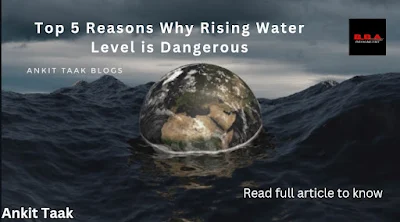The Earth's weather is rapidly changing, and one of the most alarming outcomes of worldwide warming is the rising water tiers in our oceans and seas. Melting glaciers, thermal expansion, and the growing frequency of extreme weather events have all contributed to this phenomenon. The dangers related to growing water stages can not be ignored, as they pose a vast danger to each human populations and the environment. In this newsletter, we can discover the pinnacle five reasons why growing water tiers are risky and the urgent need for collective movement to mitigate this global crisis.
Author: Ankit Taak
∆ Coastal Flooding and Erosion
Rising water tiers notably increase the threat of coastal flooding and erosion. Low-lying coastal regions, populated areas, and crucial infrastructure are all liable to being submerged via better tides and storm surges. Coastal erosion is exacerbated as better water stages erode seashores and destabilize coastal ecosystems. Valuable habitats which include marshes, wetlands, and mangroves, which function natural buffers against flooding and storms, are liable to disappearing. The loss of those herbal defenses will cause greater devastating impacts on coastal groups and ecosystems.
∆ Displacement of Human Populations
One of the maximum concerning effects of rising water tiers is the displacement of human populations. As coastal areas become uninhabitable due to flooding and erosion, thousands and thousands of humans may be forced to abandon their homes and searching for shelter somewhere else. This mass migration can cause humanitarian crises, as governments and communities warfare to house the influx of climate refugees. The ability for social unrest, conflicts over resources, and strained global family members becomes a full-size subject as people vie for new territories and resources.
∆ Threats to Freshwater Resources
Rising water degrees additionally pose a danger to freshwater resources. As seawater infiltrates inland, it contaminates aquifers and freshwater resources, rendering them mistaken for human consumption and agricultural use. Many coastal areas depend on underground freshwater reservoirs as their number one source of ingesting water, and the intrusion of saltwater into these resources may be disastrous for nearby communities. This shortage of freshwater can lead to extreme droughts, crop disasters, and intensified opposition for restricted water resources.
∆ Destruction of Marine Ecosystems
The rise in water stages has extreme effects for marine ecosystems and biodiversity. Coral reefs, seagrass beds, and other crucial habitats are prone to bleaching and destruction because of accelerated exposure to sunlight and temperature adjustments. Additionally, ocean acidification, a result of extended carbon dioxide absorption, similarly threatens marine life, especially organisms with calcium carbonate shells like corals and mollusks. The lack of marine biodiversity not most effective disrupts sensitive ecosystems but also has some distance-attaining influences on the fishing enterprise and coastal economies that rely on healthy marine sources.
∆ Amplification of Extreme Weather Events
Rising water stages contribute to the amplification of excessive weather activities such as hurricanes, typhoons, and tropical storms. As sea ranges upward push, storm surges turn out to be extra powerful and unfavorable. Coastal communities are uncovered to higher dangers of devastating wind damage and flooding, main to more widespread financial losses and lack of lifestyles. The impact of such excessive activities is some distance-accomplishing, causing harm to crucial infrastructure, disrupting food and water substances, and hindering put up-disaster restoration efforts.
√ Conclusion
The dangers of growing water tiers are plain and require instantaneous attention and worldwide cooperation. The outcomes of state of no activity are catastrophic, impacting now not handiest coastal regions however also global climate styles, ecosystems, and human societies. To combat rising water degrees, governments, groups, and people have to prioritize sustainable practices, reduce greenhouse gasoline emissions, and invest in adaptation measures to defend susceptible communities and ecosystems.
The urgency of the state of affairs demands a collective attempt to mitigate the affects of climate change and promote resilience within the face of growing water stages. By operating collectively, we are able to try to steady a sustainable destiny for generations to return and make sure the safety and stability of our planet.
Rising seal level
Global warming
RSL
GW
NASA
ANKIT TAAK BLOGS



.jpeg)
.jpeg)


Please Don't Spam Here